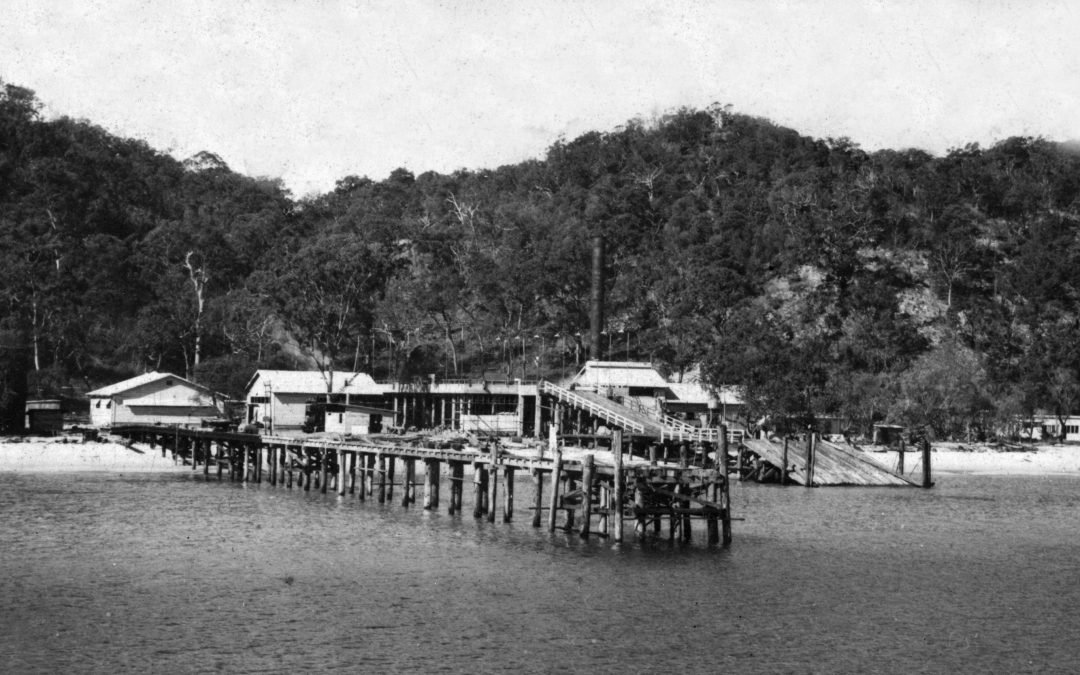Tangalooma Whaling Station
Tangalooma Whaling Station, Moreton Island, c. 1952 – 1961
Whales were first hunted in Australian waters in the late-eighteenth century. By the end of the nineteenth, intensive commercial whaling had caused whale numbers to fall precipitously. From 1935, protection was extended to the much-reduced southern right whale population. Other whale species were not so lucky, with humpback whales continuing to be hunted until the 1960s and sperm whales into the late-1970s. The trade was officially prohibited in 1979.
In 1952, the Australian company Whale Products Pty Ltd. opened Moreton Island’s Tangalooma Whaling Station – the largest land-based whaling station in the southern hemisphere. In its first year, it killed and processed 600 whales. Their bodies were used for oil (glycerine, cosmetics, soap, margarine, and pharmaceuticals), meat (pet food and fertiliser), tendons (surgical stitches and tennis racket strings), glands (pharmaceuticals), gelatine (jellies and photographic films), and bones and offal (fertiliser and livestock meal).
By the end of the 1950s, demand for whale oil (the most commercially important whale product) was falling, partially due to competition from vegetable oil producers. Whaling had also been rendered impractical due to a sharp decline in population numbers, with whales becoming so scarce that they needed to be spotted by light plane. The station finally closed in 1962, having taken only sixty-eight whales that year. During its decade of operation, it killed 6,277 humpbacks and one blue whale. By 1962, the humpback population of the east coast had declined from 15,000 to 500.
In 1965, humpback whales were added to the protected species list. Tangalooma was already making a fresh start, with a Gold Coast-based syndicate purchasing the facility for resort development in 1963. In 1980, it was sold to the Osbourne family, who still operate it as a resort. In 2013, there were an estimated 19,000 humpbacks in the waters along the east coast. This population now makes money for whale-watchers rather than whalers, with over 500,000 tourists taking whale-watching trips in Queensland between late 2016 and early 2018.
See:
Australian Government (Department of the Environment and Energy). “Whaling.” Australian Government: Department of Environment and Energy (https://www.environment.gov.au/marine/marine-species/cetaceans/whaling).
Matthew Connors. “You Don’t Have to Travel Far from Brisbane to See Whales.” The Courier-Mail, 7th July 2018 (https://www.couriermail.com.au/news/queensland/qweekend/you-dont-have-to-travel-far-from-brisbane-to-see-whales/news-story/0bbd13bd87547491188c2986bcf0f927).
Shelley Lloyd. “Humpback Whale Numbers Recover Off Queensland but New Risks Threaten Survival.” ABC News, 4th May 2019 (https://www.abc.net.au/news/2019-03-04/humpback-whale-migration-numbers-off-southern-queensland/10867396).
Tangalooma Island Resort. “Whaling Station.” Tangalooma Island Resort. (https://www.tangalooma.com/assets/Whale%20Blog/History%20of%20Tangalooma%20Whaling%20Station.pdf)
Queensland Government (Department of Environment and Science). “Humpback Whales Megaptera novaeangliae.” Queensland Government: Environment (https://environment.des.qld.gov.au/wildlife/animals-az/whales.html).

